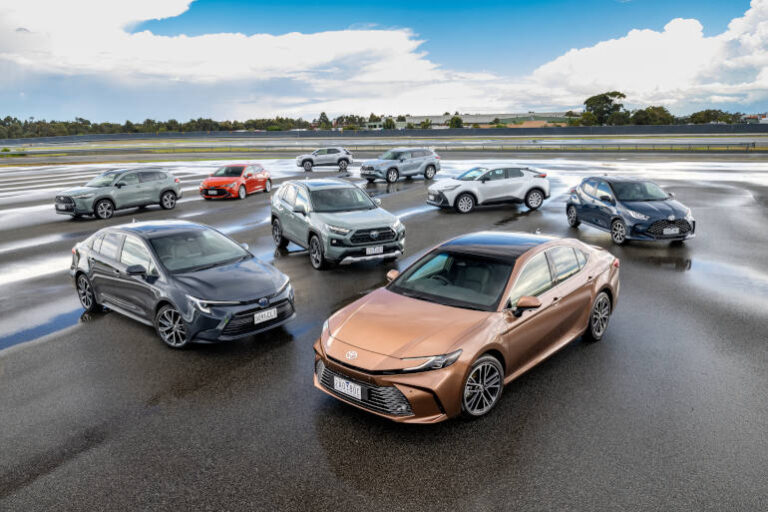For over two decades, Toyota has been a dominant force in the hybrid vehicle space, pioneering the market since the Prius’ introduction to Australia in 2001. The company’s commitment to hybrid technology has shaped consumer perceptions, moving hybrids from niche products to desirable, mainstream choices—a success most evident with the RAV4 Hybrid’s runaway popularity. Toyota has underlined the rapidly growing popularity of electrified vehicles by delivering its 500,000th hybrid car in Australia in late 2024.
“This has been amply demonstrated by the success of RAV4, which has been Australia’s best-selling car for each of the past six months,”
Toyota Australia Vice President of Sales, Marketing & Franchise Operations Sean Hanley.
In 2024, Toyota is significantly expanded its hybrid lineup, a move that highlights not only its market leadership but also its strategic response to the rapidly evolving regulatory landscape. With Australia set to introduce New Vehicle Efficiency Standards (NVES) in 2025, this increase in hybrid availability reflects Toyota’s proactive efforts to address tightening emissions regulations and offset the environmental impact of its top-selling diesel-powered vehicles.
A Broader Hybrid Offering
Toyota’s lineup in 2024 underscored its commitment to offering hybrids across a diverse range of vehicle categories. From compact sedans and hatchbacks to SUVs, the company’s hybrid models cater to a wide audience. The Corolla and Camry Hybrids continue to hold strong appeal for urban commuters, while the RAV4 Hybrid remains a favourite among families and fleets seeking fuel efficiency and practicality. New additions, such as hybrid variants of the Kluger and Yaris Cross, further broaden the options available to Australian consumers.
“With supply now back to normal for most of our range, the 2024 figures demonstrate that consumers regard Toyota hybrids as capable, practical, and affordable cars that can help them reduce their fuel consumption and carbon footprint – today,” Hanley added.
RAV4 Hybrid led the sales charts with 55,902 units delivered in 2024, more than double the 25,666 sold in 2023, cementing its position as Australia’s most popular hybrid vehicle of all time with a total of 167,776 sales.
This expansion demonstrates Toyota’s confidence in hybrid technology as a transitional solution. While the industry shifts towards full electrification, hybrids offer a practical middle ground, providing lower emissions without the range and charging infrastructure concerns that still deter some EV buyers.
Positioning for the NVES Era
The impending New Vehicle Efficiency Standards will place strict limits on average fleet emissions, requiring manufacturers to meet specific benchmarks or face penalties. For Toyota, whose diesel-powered HiLux and LandCruiser are among Australia’s best-selling vehicles, the expanded hybrid range serves as a crucial emissions offset strategy.
Diesel vehicles, while popular for their durability and towing capacity, contribute significantly to overall fleet emissions. By increasing the proportion of hybrids in its lineup, Toyota can balance its portfolio and ensure compliance with the upcoming standards. This approach aligns with a broader industry trend, as automakers pivot towards greener technologies to meet regulatory and consumer demands.
The RAV4 Effect
Central to Toyota’s hybrid success is the RAV4, which has redefined consumer expectations for hybrid vehicles. Offering a seamless blend of performance, efficiency, and practicality, the RAV4 Hybrid has demonstrated that eco-friendly choices need not involve compromise.
“Australians are tightening their belts across the board and, with petrol prices hovering at about $2 a litre, hybrids are an attractive proposition,” Hanley remarked.
Looking Ahead
While Toyota’s expanded hybrid range is impressive, it also raises questions about its long-term electrification strategy. The company has been slower than some competitors to embrace fully electric vehicles (EVs), a stance that has drawn criticism in an increasingly EV-focused market. However, Toyota’s hybrid push suggests a pragmatic approach: leveraging its hybrid expertise to meet immediate regulatory challenges while continuing to develop EV technology behind the scenes.
As we enter 2025, the hybrid market is likely to see even greater competition, with other manufacturers introducing models to meet the NVES requirements. For now, though, Toyota remains the undisputed leader, setting the standard for what hybrid vehicles can achieve and ensuring a smoother transition to a more sustainable automotive future.







